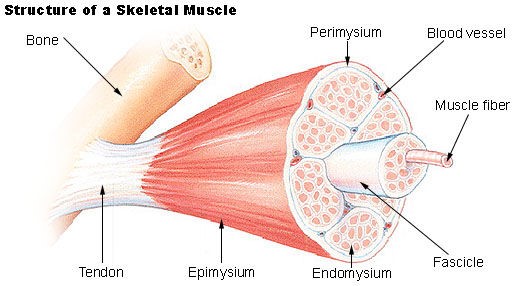MusculoSkeletal System Questions Review & Extra Credit Part 1 of 2
Muscular System Practice Review Test Questions
- Place the following items in order from simple to most complex:
1. Cardiac muscle fiber 2. Ca++ 3. Myofilament 4. Sarcolemma 5. Actin
- A) 4.5.1.3.2.
- B) 5.1.3.2.4.
- C) 2.5.3.4.1.
- D) 3.1.2.5.4.
- E) 1.4.3.5.2.
2. Skeletal muscle tissue is ________________, but Smooth muscle tissue is _______________.
- A) striated / multinucleate
- B) smooth / uninucleate
- C) striated / uninucleate
- D) multinucleate / striated
- E) uninucleate / smooth
3. Why is Cardiac muscle tissue so different from skeletal and smooth?
- A) It is found only in the cardiovascular system and contains tight junctions
- B) It is found only in the heart and contains intercalated discs
- C) It is found in the heart and blood vessels, and contains intercalated discs
- D) It is found in the blood vessels and contains neuromuscular junctions
- E) It is found only in the cardiac viscera and contains gap junctions
4. It’s so crazy to think that muscle fibers kind of act like neurons! In fact, they _____.
- A) are electrically excitable
- B) respond to neurotransmitters
- C) generate graded potentials
- D) A and B are correct
- E) A, B and C are correct
5. Which connective tissue structure is correctly paired to its description?
- A) endomysium – surrounds cells
- B) epimysium – surrounds cells
- C) perimysium – surrounds muscle
- D) tendon – surrounds muscle
- E) fascicle – surrounds cells
6. Your friend is having a hard time understanding skeletal muscle cells and has asked you for help. You look at their notes, and immediately find some errors. In fact, which note entry written below is wrong?
- A) each muscle cells is innervated by many different nerves
- B) muscle tissue is highly vascular
- C) skeletal muscles are controlled by somatic motor neurons
- D) smooth muscles have calmodulin instead of a troponin complex
- E) muscle cell metabolism varies with twitch speed
7. Transverse tubules:
- A) are actually tiny pockets of plasma membrane that extend into the muscle cell.
- B) are filled with interstitial fluid.
- C) prevent the spread of an action potential to the interior of a myofiber.
- D) A and B are correct.
- E) A, B and C are correct
- A) include contractile proteins which stabilize the structure of the sarcomere.
- B) include the contractile proteins actin and myosin.
- C) include regulatory proteins that keep thick and thin filaments in proper alignment.
- D) include structural proteins that decrease the extensibility and elasticity of the myofiber.
- E) include structural proteins the turn the contraction process off or on.
10. While many events take place during muscle contraction, which event most definitely does not?
- A) myosin heads for a cross bridge with actin
- B) the z lines are pulled closer together
- C) The sarcomere shortens
- D) The myofiber and the muscle itself shorten.
- E) The thick and thin filaments shorten
11. Place the events of a muscle contraction in order of occurrence.
1. Myosin forms cross bridge 2. Ca++ binds troponin 3. Ca++ released from terminal cisternae 4. Thin filament moves 5. Power stroke 6. Tropomyosin shifts
- A) 1.4.3.2.
- B) 1.4.2.3.
- C) 1.3.4.2.
- D) 1.3.2.4. E) 1.2.3.4.
12. Which of the following terms is match to its description?
- A) Incomplete tetanus – rapid stimulation, muscle cell does not relax between twitches
- B) Treppe – rapid stimulation, individual twitches evident
- C) Wave Summation – two twitches, no relaxation between events
- D) Temporal Summation – muscle response to one stimulus
13. Practice labeling the following:
Skeletal System
1.In a bone that experienced a marked decline in mechanical stress, the activity of osteoblasts would _____________ and the deposition of new bone matrix would ___________.
- A. Increase – increase
- B. Increase – decrease
- C. Decrease – decrease
- D. Decrease – increase
2. Both the sternum and the vertebrae are examples of:
- A. Long bones
- B. Short bones
- C. Flat bones
- D. Irregular bones
- E. None of the above
3. Bones contain: I. Adipose tissue II. Nervous tissue III. Connective tissue IV. Simple squamous epithelial tissue
- A. I, II, III, and IV
- B. I and III only
- C. I and II only
- D. II and III only
- E. II, III, and IV only
4. Which of the following would be capable of the highest rate of collagen secretion?
- A. Osteoblast
- B. Osteocyte
- C. Osteoclast
- D. All of the Above
- E. None of the Above
- F. Choices a and c only
5. Osseous tissue contains very little extracellular matrix.
- True
- False
6.Critical Thinking: Growth hormone is often used clinically to treat children who are unusually short due to a growth hormone deficiency.
- What organ is probably not functioning in these children?
- How does the GH help the children?
- Why would administering GH to an extremely short 29yo woman have little effect on her height?




